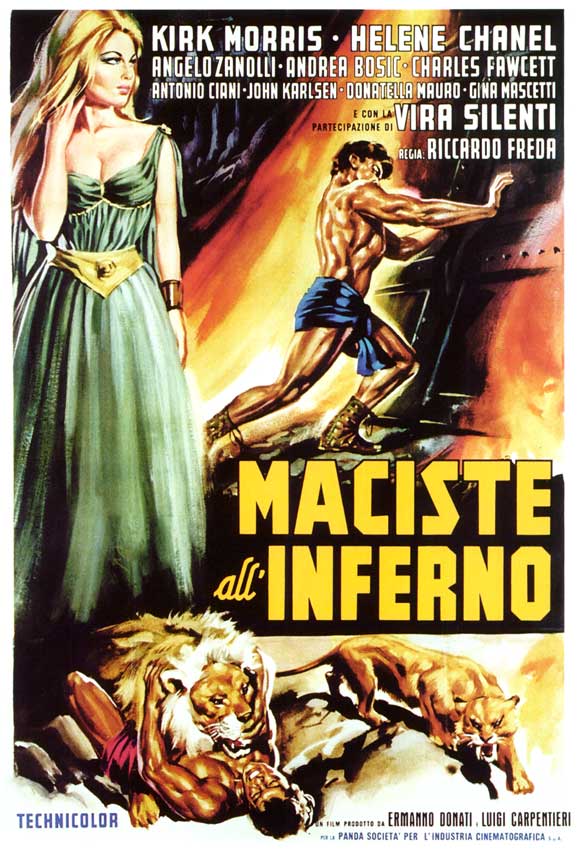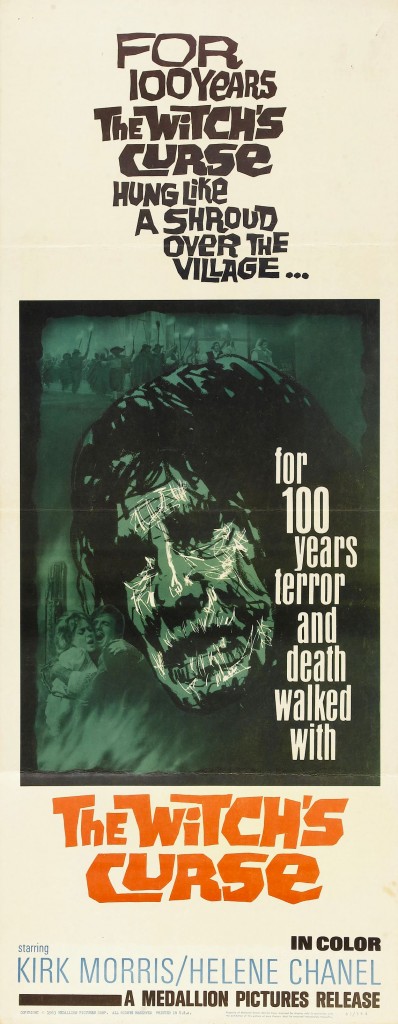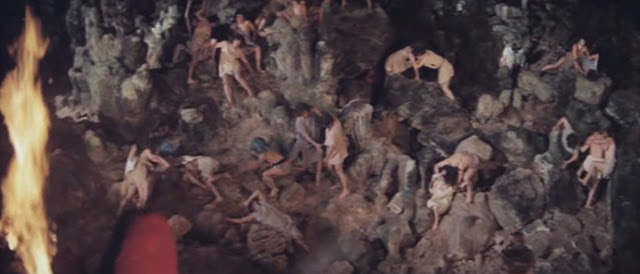Peplum Populist: Maciste in Hell (The Witch’s Curse)
 Among the canon of Italian peplum (sword-and-sandal) films made from 1958 to 1965, there are three special horror-fantasia entries. I’ve already written about Mario Bava’s classic Hercules in the Haunted World (1961). In the future I’ll look at the same year’s Goliath and the Vampires, which was co-directed by famed Italian Western director Sergio Corbucci, the man who helmed the original Django (1966).
Among the canon of Italian peplum (sword-and-sandal) films made from 1958 to 1965, there are three special horror-fantasia entries. I’ve already written about Mario Bava’s classic Hercules in the Haunted World (1961). In the future I’ll look at the same year’s Goliath and the Vampires, which was co-directed by famed Italian Western director Sergio Corbucci, the man who helmed the original Django (1966).
Today I’m spending my peplum-time with the third dark fantasy, Maciste in Hell (1962), yet another movie featuring Italian homegrown hero Maciste. (Oh, wait. Goliath and the Vampires is also a Maciste film. Damn these U.S. title changes!) Although Maciste in Hell isn’t as fantastic as Hercules in the Haunted World — it’s hard to best Mario Bava when it comes to doing weird horror on the cheap — it’s on the top of the pile as far a sword-and-sandal movies go. And its Amazon VOD presentation is relatively high quality. The picture has the vertical squeeze problem of Perseus the Invincible, but at least you have the entire image and a decent print.
The idea of Maciste journeying to the underworld like Dante or Aeneas wasn’t new: Maciste in Hell (Maciste all’inferno) is also the title of one of the silent Maciste films that were hits in Italy in the 1910s and ‘20s. The two movies don’t have any story connection aside from the hero in an infernal setting, and the silent Maciste is a different character and phenomenon from the 1960s version. But Maciste in Hell ‘62 is also different from other peplum films of its time, and not just in its overt supernatural horror elements. Where Maciste’s standard stomping grounds are the ancient/mythic Mediterranean, here he pops up in seventeenth-century Scotland. Maciste has a reputation for shifting about in time and place: I dealt with him in prehistory in Colossus of the Stone Age, and recently watched him battle Mongols in China in Maciste at the Court of the Great Khan (retitled Samson and the 7 Miracles of the World in the U.S.). Even so, Scotland in the Early Modern Era is pushing against the sword-and-sandal barriers.
But Maciste remains recognizably a peplum hero regardless of the Caledonian surroundings. He wears his standard loincloth and boots and flexes super strength to hurl boulders, wrestle various animals, and tussle with another strongman. And once Maciste trudges into the underworld, he’s comfortably ensconced in sword-and-sandal territory.
However, before Maciste even makes his entrance, viewers could be forgiven for thinking they’re watching a Euro-horror film in the mold of Mario Bava’s 1960 classic The Mask of Satan (Black Sunday). These first twenty minutes are a compact version of the Gothic horror films becoming popular at the time. A witch is executed, but before she expires she summons a curse on the village. Cut to a hundred years later. A twisted tree stands on the spot where the witch, Old Martha Gaunt, was burnt to ashes. Local women are drawn to the tree in hysterics where they attempt to hang themselves from its black branches. But no one in the village of Loch Laird dares cut down the tree for fear of incurring an even worse curse from the spirit of the dead witch.
 One of Old Martha Gaunt’s descendants, a young woman also named Martha Gaunt (Vira Silenti) marries Charley Law (Angelo Zanolli), a wealthy squire, and moves into an abandoned ancestral castle near the village. A few odd events occur as they enter the castle, hinting at a haunting movie that never happens. The villagers hear of the arrival of a descendant of Martha Gaunt and form a instant torch-wielding mob. They seize young Martha and are on the verge of hanging her when superhero Maciste (Kirk Morris, stage name of Adriano Bellini) arrives … on horseback, wearing nothing but a loincloth and boots, in the middle a Scottish night. Immediately, he bends bars! Yes, we’re shifting into the world of peplum.
One of Old Martha Gaunt’s descendants, a young woman also named Martha Gaunt (Vira Silenti) marries Charley Law (Angelo Zanolli), a wealthy squire, and moves into an abandoned ancestral castle near the village. A few odd events occur as they enter the castle, hinting at a haunting movie that never happens. The villagers hear of the arrival of a descendant of Martha Gaunt and form a instant torch-wielding mob. They seize young Martha and are on the verge of hanging her when superhero Maciste (Kirk Morris, stage name of Adriano Bellini) arrives … on horseback, wearing nothing but a loincloth and boots, in the middle a Scottish night. Immediately, he bends bars! Yes, we’re shifting into the world of peplum.
Although Maciste rescues Martha from the mob, the village council decides to burn her at the stake anyway after Old Martha Gaunt’s spirit frames her with the spectacle of causing a Bible to burst into flames when the girl touches it. A sympathetic doctor (Charles Fernley Fawcett) tells Maciste the only way to save Martha from execution is to remove the cursed tree. When Maciste lifts up the tree, he uncovers a passage into Hell. Maciste descends into the underworld to locate the spirit of Old Martha Gaunt to lift the curse. And everything goes wonderfully weird.
Inexpensive cavern sets were the bane of many sword-and-sandal films; Colossus of the Stone Age was especially guilty of this. But the filmmakers of Maciste in Hell went on location for their version of hell, using the Castellana Caves and splashing them with eerie, Bava-esque colored lights. The effect is gorgeous and provides the entire production with a more expensive feeling. It even challenges Hercules in the Haunted World, although it can’t quite match Bava’s visual flair. When Maciste walks through a chamber filled with writhing souls in torment, it briefly looks like a living Hieronymous Bosch painting. There are some direct visual echoes of Bosch in the torment of the damned. With the accompanying of wailing voices on the soundtrack, the scene is grotesque nightmare.
Maciste wanders through a constant barrage of obstacles and odd visuals. He starts with a peplum standard, fighting a lion, but then finds more horrific oddities, such as giant flaming iron doors and a chamber raining down deadly sparks. (Maciste hefts up a huge boulder to hold over himself as he passes through the sparks. He makes good use of super strength throughout.) He wrestles a howling giant who attempts to prevent him from crossing a cavern and escapes from a descending spike trap. His final challenge is facing a bull stampede trying to drive him into the flames. With the exception of a sloppily staged “fight” with snakes that Maciste has to pick up in order to make them attack him, all of the infernal sequences are dark fantasy delights.
Kirk Morris as Maciste is … not bad. It’s the best performance I’ve seen from him as a strongman hero. He emotes well over the torment he undergoes when he burns his hands against the iron doors, and he shows better rapport with the other actors than he often does; in Colossus and the Headhunters, Morris often seems unaware the other performers are even speaking to him. He can still fall into robotic mode, such as when Maciste crosses the chamber of the damned. Morris appears bored as he travels through the phantasmagoria, nonchalantly glancing left and right as if nothing surprising is going on.
The scene-stealer is Hélène Chanel as Fania, a beautiful woman who appears to heal Maciste’s burned hands and then offers to help him find the witch. Of course, it’s another deception: Fania is the femme fatale sorceress common to sword-and-sandal movies. Chanel appeared in four movies with Kirk Morris, and the two have a bit of steamy chemistry, which further helps Morris overcome his acting limitations. The beautiful blonde-haired Chanel in her angelic clothing creates a powerful visual contrast among the infernal settings, and she plays the eventual tragedy of Fania extremely well to deliver an emotion-based rather than action-based climax. It’s unusual for a peplum, but it works and Chanel is a big reason for it.
This is the only time a Maciste movie offers something akin to an actual history of the character. As a budget-saving maneuver, the movie stops right before the climax to run a few minutes of a clip show from three other Maciste films, all of which had Maciste’s name removed in their U.S. titles: Atlas in the Land of the Cyclops, Son of Samson, and Samson and the 7 Miracles of the World. There’s a passable excuse for running the money-saving footage: Fania’s magic has caused Maciste to lose his memories of his Hell Quest, and the tortured Prometheus tells the hero to look into an enchanted pool to experience his history and regain his memory. Kirk Morris starred in Atlas in the Land of the Cyclops, and insert shots place him into the other two movies, although Gordon Scott can be seen clearly in the Samson and the 7 Miracles footage. Although Maciste in other films mentions his role is to travel the world fighting evil (which he says here as well), this is the nearest to stating explicitly that he’s an immortal wanderer in time, since the magic pool shows him in ancient Egypt and Mongol-ruled China, periods thousands of years apart.
 Director Riccardo Freda directed a number of peplum, including The White Warrior with Steve Reeves and a flashback subject in this film, Samson and the 7 Miracles of the World. He had experience with pepla even before the start of the boom in 1958, directing the historical epics Sins of Rome (1953) and Theodora, Slave Empress (1954). He also had some experience with horror, and merges his skills here to deliver his best known film.
Director Riccardo Freda directed a number of peplum, including The White Warrior with Steve Reeves and a flashback subject in this film, Samson and the 7 Miracles of the World. He had experience with pepla even before the start of the boom in 1958, directing the historical epics Sins of Rome (1953) and Theodora, Slave Empress (1954). He also had some experience with horror, and merges his skills here to deliver his best known film.
Maciste in Hell was released in the U.S. through distributor Medallion Pictures as The Witch’s Curse. Since Medallion Pictures opted not to commission their own English dub and instead use the one made in Rome, Maciste got to keep his own name in the dialogue. But Medallion cut about fifteen minutes from the movie, making the slender story ragged and oblique. The Amazon streaming version comes from an uncut Italian print; unfortunately, there’s no English dubbing for the cut scenes or any subtitles. At least viewers don’t lose out on visuals, and the sudden appearance of Italian dialogue makes it obvious what the U.S. version chopped out. Most of the cuts come in the first half hour during the Scottish sections to reduce time spent between young Martha and Charley Law and rush to the Hell part — as well as rush important details about what’s at stake in the underworld.
The Amazon VOD version is good as far as most sword-and-sandal movies go, but Maciste in Hell is begging the gods for a boutique label to rescue it with a proper widescreen presentation sourced from a quality print of the complete Italian cut. Hopefully, it can be presented with the Italian soundtrack and English subtitles, with the English dub as an audio option, as was done for the Hercules and the Haunted World DVD from Fantoma.
Ryan Harvey is one of the original bloggers for Black Gate, starting in 2008. He received the Writers of the Future Award for his short story “An Acolyte of Black Spires,” and his stories “The Sorrowless Thief” and “Stand at Dubun-Geb” are available in Black Gate online fiction. A further Ahn-Tarqa adventure, “Farewell to Tyrn”, is currently available as an e-book. Ryan lives in Costa Mesa, California where he works as a professional writer for a marketing company. Occasionally, people ask him to talk about Edgar Rice Burroughs or Godzilla in interviews.
I may check this out. I love Hercules and the Haunted World, and so many of these sword and sandals movies had so much potential. But they are often disappointing by being slow in pacing or incomprehensible. How would you rate this compared to Hercules and the Haunted World?
To me, this movie becomes much more watchable once Maciste gets down into hell, and specifically, when he meets Fania. Then, we can watch the Italians do what they do best: erotic tension and romance!